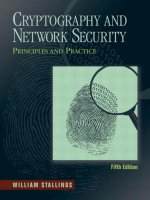04 network construction, inference, and deconvolution
Bạn đang xem bản rút gọn của tài liệu. Xem và tải ngay bản đầy đủ của tài liệu tại đây (41.1 MB, 60 trang )
CS224W: Analysis of Networks
Jure Leskovec, Stanford University
Feature matrices, relationship tables, time
series, document corpora, image datasets, etc.
10/4/18
Jure Leskovec, Stanford CS224W: Analysis of Networks
2
Network construction
and inference
Today: How to construct and infer networks
from raw data?
10/4/18
Jure Leskovec, Stanford CS224W: Analysis of Networks
3
Jonas Richiardi et al., Correlated gene expression supports synchronous activity in
brain networks. Science 348:6240, 2015.
10/4/18
Jure Leskovec, Stanford CS224W: Analysis of Networks
4
1) Multimode Network Transformations:
§ K-partite and bipartite graphs
§ One-mode network projections/folding
§ Graph contractions
2) K-Nearest Neighbor Graph Construction
3) Network Deconvolution:
§ Direct and and indirect effects in a network
§ Inferring networks by network deconvolution
10/4/18
Jure Leskovec, Stanford CS224W: Analysis of Networks
5
¡
Most of the time, when we create a network, all nodes
represent objects of the same type:
§ People in social nets, bus stops in route nets, genes in gene nets
¡
Multi-partite networks have multiple types of nodes,
where edges exclusively go from one type to the other:
§ 2-partite student net: Students <-> Research projects
§ 3-partite movie net: Actors <-> Movies <-> Movie Companies
Network on the left is a social bipartite
network. Blue squares stand for people and
red circles represent organizations
10/4/18
Jure Leskovec, Stanford CS224W: Analysis of Networks
7
¡
Example: Bipartite student-project network:
§ Edge: Student ! works on research project "
Students
Research projects
¡
!
"
Two network projections of student-project network:
§ Student network: Students are linked if they work together
in one or more projects
§ Project network: Research projects are linked if one or
more students work on both projects
¡
10/4/18
In general: K-partite network has K one-mode network
projections
Jure Leskovec, Stanford CS224W: Analysis of Networks
8
¡
Example: Projection of bipartite student-project network
onto the student mode:
Students
1
2
3
4
5
Research
projects
¡
One-mode student projection
3
5
1
2
4
Consider students 3, 4, and 5 connected in a triangle:
§ Triangle can be a result of:
§ Scenario #1: Each pair of students work on a different project
§ Scenario #2: Three students work on the same project
§ One-mode network projections discard some information:
§ Cannot distinguish between #1 and #2 just by looking at the projection
10/4/18
Jure Leskovec, Stanford CS224W: Analysis of Networks
9
¡
One-mode projection onto student mode:
§ #(projects) that students ! and " work together on is
equivalent to the number of paths of length 2
connecting ! and " in the bipartite network
¡
Let # be incidence matrix of student-project net:
1 if ! works on project 6
#$% = '
0 otherwise
Students
¡
# is an 9 × ; binary non-symmetric matrix:
Projects
§ 9 is #(students), ; is #(projects)
10/4/18
Jure Leskovec, Stanford CS224W: Analysis of Networks
10
¡
¡
Idea: Use ! to construct various one-mode network projections
Students
Weighted student network:
' , # projects that 4 and 7 collaborate on
"#$ = & #$
0 otherwise
Projects
A
§ "#$ = ∑>?@ !#> !$> , i.e., the number of paths of length 2 connecting
students 4 and 7 in the bipartite network
§ B = CCD and "## represents #(projects) that student 4 works on
¡
Similarly, weighted project network:
' , # students that work on I and J
E>F = & >F
0 otherwise
§ E>F = ∑K#?@ !#> !#F , i.e., the number of paths of length 2 connecting
projects I and J in the bipartite network
§ L = CD C and E>> represents #(students) that work on project I
¡
Next: Use B and L to obtain different network projections
10/4/18
Jure Leskovec, Stanford CS224W: Analysis of Networks
11
¡
Construct network projections by applying a node
similarity measure to ! and "
¡
Two node similarity measures:
§ Common neighbors: #(shared neighbors of nodes)
§ Student network: # and $ are linked if they work together in % or
more projects, i.e., if &'( ≥ *
§ Project network: + and , are linked if % or more students work on
both projects, i.e., if -./ ≥ *
§ Jaccard index:
§ Common neighbors with a penalization for each non-shared
neighbor:
§ Ratio of shared neighbors in the complete set of neighbors for 2 nodes
§ Student network: # and $ are linked if they work together in at least
0 fraction of their projects, i.e., if &'( /(&'' + &(( − &'( ) ≥ 6
§ Project network: + and , are linked if at least 0 fraction of their
students work on both projects, i.e., if -./ /(-.. + -// − -./ ) ≥ 6
10/4/18
Jure Leskovec, Stanford CS224W: Analysis of Networks
12
Homework 1
DISEASOME
Human Disease Network
(HDN)
Charcot-Marie-Tooth disease
Spastic ataxia/paraplegia
Ataxia-telangiectasia
Perineal hypospadias
Silver spastic paraplegia syndrome
Sandhoff disease
Spinal muscular atrophy
disease genome
AR
Androgen insensitivity
ATM
T-cell lymphoblastic leukemia
BRCA1
Papillary serous carcinoma
Lipodystrophy
Amyotrophic lateral sclerosis
disease phenome
Prostate cancer
BRCA2
CDH1
Ovarian cancer
GARS
Lymphoma
HEXB
Disease Gene Network
(DGN)
LMNA
ALS2
HEXB
BSCL2
VAPB
GARS
AR
KRAS
Androgen insensitivity
Prostate cancer
Breast cancer
Perineal hypospadias
Pancreatic cancer
Lymphoma
Wilms tumor
Breast cancer
Ovarian cancer
Pancreatic cancer
Papillary serous carcinoma
Fanconi anemia
T-cell lymphoblastic leukemia
Wilms tumor
Spinal muscular atrophy
Sandhoff disease
Lipodystrophy
Charcot-Marie-Tooth disease
Ataxia-telangiectasia
Amyotrophic lateral sclerosis
Silver spastic paraplegia syndrome
Spastic ataxia/paraplegia
Fanconi anemia
LMNA
MSH2
ATM
BRCA2
BRIP1
PIK3CA
TP53
BRCA1
KRAS
RAD54L
TP53
MAD1L1
RAD54L
MAD1L1
PIK3CA
VAPB
CHEK2
CHEK2
CDH1
MSH2
BSCL2
ALS2
BRIP1
Kwang-Il Goh et al., The human disease network. PNAS, 104:21, 2007.
Fig. 1. Construction of the diseasome bipartite network. (Center) A small subset of OMIM-based disorder– disease gene associations (18), where circles and rectangles
10/4/18
Jure Leskovec,
Stanford
CS224W:
Analysis
of Networks
13
correspond
to disorders and disease genes, respectively.
A link
is placed
between
a disorder
and a disease gene if mutations in that gene lead to the specific disorder.
The size of a circle is proportional to the number of genes participating in the corresponding disorder, and the color corresponds to the disorder class to which the disease
belongs. (Left) The HDN projection of the diseasome bipartite graph, in which two disorders are connected if there is a gene that is implicated in both. The width of
a link is proportional to the number of genes that are implicated in both diseases. For example, three genes are implicated in both breast cancer and prostate cancer,
DISEASOME
disease phenome
ease Network
¡ Issue:
DN)
disease genome
Folded gene network
contains many cliques:
Ataxia-telangiectasia
Perineal hypospadias
Androgen insensitivity
ATM
T-cell lymphoblastic leukemia
BRCA1
§ Why do cliques arise in the folded
gene network?
disease
Papillary serous carcinoma
Lipodystrophy
Silver spastic paraplegia syndrome
scular atrophy
¡
Androgen insensitivity
Perineal hypospadias
Prostate cancer
§ Homework 1
Sandhoff disease
Lymphoma
GARS
Lymphoma
HEXB
Breast cancer
Spinal muscular atrophy
Sandhoff disease
Lipodystrophy
Charcot-Marie-Tooth disease
Silver spastic paraplegia syndrome
Spastic ataxia/paraplegia
10/4/18
ALS2
LMNA
HEXB
BSCL2
VAPB
GARS
AR
LMNA
ATM
MSH2
BRCA2
BRIP1
PIK3CA
TP53
BRCA1
KRAS
RAD54L
TP53
MAD1L1
RAD54L
MAD1L1
CHEK2
CHEK2
PIK3CA
VAPB
Solution: Use graph
contraction to eliminate cliques
Amyotrophic lateral sclerosis
Disease Gene Network
(DGN)
KRAS
§ Computational complexity of
many algorithms depends on the
size and number of large cliques
Wilms tumor
Papillary serous carcinoma
nemia
T-cell lymphoblastic leukemia
¡
CDH1
Cliques make the network
difficult to analyze:
Ovarian cancer
Ataxia-telangiectasia
BRCA2
Ovarian cancer
Pancreatic cancer
Breast cancer
AR
CDH1
MSH2
BSCL2
ALS2
BRIP1
Fanconi anemia
Jure Leskovec, Stanford CS224W: Analysis of Networks
A clique of 9 gene nodes
14
¡
Graph contraction: Technique for computing
properties of networks in parallel:
§ Divide-and-conquer principle
¡
Idea:
§ Contract the graph into a smaller graph, ideally a
constant fraction smaller
§ Recurse on the smaller graph
§ Use the result from the recursion along with the
initial graph to calculate the desired result
¡
10/4/18
Next: How to contract (“shrink”) a graph?
Jure Leskovec, Stanford CS224W: Analysis of Networks
15
Start with the input graph !:
¡
1. Select a node-partitioning of ! to guide the contraction:
Partitions are disjoint and they include all nodes in !
§
2.
3.
4.
5.
¡
Contract each partition into a single node, a supernode
Drop edges internal to a partition
Reroute cross edges to corresponding supernodes
Set ! to be the smaller graph; Repeat
Example: one round of graph contraction:
3 partitions: a, d, e
b
a
e
d
a
c
f
d
Identify partitons
10/4/18
e
a
e
d
Contract
Jure Leskovec, Stanford CS224W: Analysis of Networks
a
e
d
Delete duplicate edges
16
e
d
a
c
a
f
a
e
e
d
d
Identify partitons
d
Contract
Delete duplicate edges
Contracting a graph down to a single node in
three rounds:
Round 1
b
a
a
e
e
a
d
c
e
a
d
f
d
e
Round 3
Round 2
a
a
a
10/4/18
Jure Leskovec, Stanford CS224W: Analysis of Networks
e
17
¡
¡
Partitions should be disjoint and include all nodes in !
Three types of node-partitioning:
§ Each partition is a (maximal) clique of nodes:
a
b
f
e
i
e
a
Contract
a
e
d
g
c
h
c
c
§ Each partition is a single node or two connected nodes:
a
b
f
e
e
a
c
g
g
Contract
e
d
c
§ Each partition is a star of nodes, etc.
10/4/18
a
Jure Leskovec, Stanford CS224W: Analysis of Networks
c
18
1) Multimode Network Transformations:
§ K-partite and bipartite graphs
§ One-mode network projections/folding
§ Graph contractions
2) K-Nearest Neighbor Graph Construction
3) Network Deconvolution:
§ Direct and and indirect effects in a network
§ Inferring networks by network deconvolution
10/4/18
Jure Leskovec, Stanford CS224W: Analysis of Networks
19
¡
K-nearest neighbor graph (K-NNG) for a set of
objects ! is a directed graph with vertex set !:
§ Edges from each " ∈ ! to its $ most similar
objects in ! under a given similarity measure:
§ e.g., Cosine similarity for text
§ e.g., %& distance of CNN-derived features for images
10/4/18
Jure Leskovec, Stanford CS224W: Analysis of Networks
21
¡
K-NNG construction is an important operation:
§ Recommender systems: connect users with similar
product rating patterns, then make recommendations
based on the user’s graph neighbors
§ Document retrieval systems: connect documents
with similar content, quickly answer input queries
§ Other problems in clustering, visualization,
information retrieval, data mining, manifold learning
¡
10/4/18
K-NNGs allow us to use network methods on
datasets with no explicit graph structure
Jure Leskovec, Stanford CS224W: Analysis of Networks
22
¡
¡
Problem: Visualize large high-dim data in 2D space
Traditional approach:
§ Compute similarities between objects
§ Project objects into a 2D space by preserving the similarities
§ Does not scale to millions of objects and hundreds of dimensions
¡
K-NNG can substantially reduce computational costs
(a) 20NG (t-SNE)
K-NNG construction
Graph visualization
(c) WikiDoc (t-SNE)
WikiDoc data (t-SNE)
Jure Leskovec, Stanford CS224W: Analysis of Networks
23
1: A typical10/4/18
pipeline of data visualization
by first constructing a K-nearest neighbor graph and then projecting
th
nto a low-dimensional space.
¡
Let’s construct a K-NNG by brute-force:
§ Given ! objects " and a distance metric
#: " ì " [0, )
Đ For each possible pair of (-, .), compute #(-, .)
§ For each ., let /0 (1) be .’s K-NN, i.e., the 2
objects in " (other than .) most similar to .
Compute similarity
Object .
Choose 3 of the
nearest objects
10/4/18
Jure Leskovec, Stanford CS224W: Analysis of Networks
24
¡
Computational cost of brute-force: !(#$ )
¡
Issues with brute-force approach:
§ Not scalable: Practical for only small datasets
§ Not general: Many custom heuristics designed to
speed up computations:
§ Many heuristics are specific to a similarity measure
§ Not efficient: Compute all neighbors for every &
§ We only need ' nearest neighbors for every &
10/4/18
Jure Leskovec, Stanford CS224W: Analysis of Networks
25









